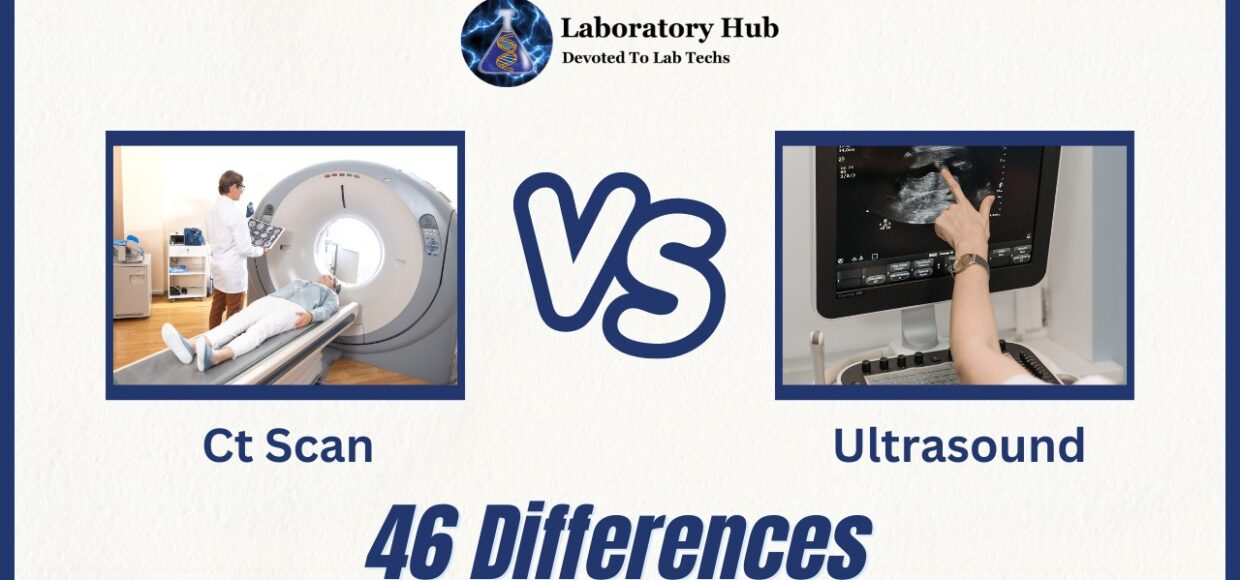46 Difference Between CT scan and Ultrasound
Medical imaging plays a pivotal role in modern healthcare, aiding in the diagnosis, treatment, and monitoring of various medical conditions. Among the array of imaging techniques available, CT scans (computed tomography) and ultrasounds stand out as essential tools, each offering unique advantages and applications. While both serve the purpose of visualizing internal structures, they operate on distinct principles, produce different types of images, and excel in specific clinical scenarios.
CT scans, based on X-ray technology, create cross-sectional images of the body by capturing X-ray beams from multiple angles. These images are then processed by a computer to generate detailed, three-dimensional representations of tissues, organs, and bones. CT scans excel in capturing fine anatomical details and are particularly valuable for diagnosing conditions such as bone fractures, tumors, and internal bleeding. However, it’s important to note that CT scans involve exposure to ionizing radiation, which carries potential risks, especially with repeated use.
On the other hand, ultrasound relies on high-frequency sound waves to produce real-time images. These sound waves bounce off tissues and organs, generating echoes that are converted into images. Ultrasounds are non-invasive, safe for patients of all ages, and particularly valuable during pregnancy, where they provide a means to monitor fetal development. Ultrasound imaging is adept at visualizing soft tissues, organs, and blood flow dynamics, making it an indispensable tool for assessing conditions like heart abnormalities, abdominal disorders, and blood clots.
Also Read: Introns vs Exons- 25 Major Differences
Differences Between CT Scans and Ultrasounds
The differences between CT scans and ultrasounds extend beyond their underlying principles. CT scans offer unparalleled image detail, making them superior for pinpointing intricate anatomical structures and detecting minute abnormalities. They are well-suited for emergency cases due to their speed and ability to visualize internal injuries comprehensively. However, the radiation exposure and higher cost associated with CT scans necessitate careful consideration.
Conversely, ultrasounds prioritize safety and real-time imaging. They are often the preferred choice during pregnancy, as they allow doctors to monitor the developing fetus without exposing the mother or unborn child to radiation. Ultrasounds are dynamic, providing insights into motion, blood flow, and tissue behavior, making them invaluable for guiding interventions like biopsies and needle insertions.
In conclusion, the selection between CT scans and ultrasounds depends on the specific medical scenario, the type of information required, and the patient’s individual needs. CT scans excel in providing detailed anatomical information, while ultrasounds prioritize safety and real-time imaging, particularly for monitoring pregnancies and assessing soft tissue dynamics. By understanding the unique strengths of these imaging techniques, medical professionals can make informed decisions to provide accurate diagnoses and optimal patient care.
Also Read: B Cells vs T Cells- Definition and 25 Key Differences
S.No. | Aspect | CT Scan (Computed Tomography) | Ultrasound |
1 | Principle | Uses X-rays to create cross-sectional images of the body. | Utilizes high-frequency sound waves for imaging. |
2 | Radiation Exposure | Involves exposure to ionizing radiation due to X-rays. | Non-ionizing, doesn’t expose patients to radiation. |
3 | Image Quality | Provides detailed and high-resolution images of internal structures. | Image quality can vary based on tissue and technique. |
4 | Contrast Enhancement | Can use contrast agents for enhanced visualization of certain tissues. | Limited contrast enhancement compared to CT. |
5 | Bone Visualization | Excellent for visualizing bones and dense tissues. | Less effective for visualizing bones. |
6 | Soft Tissue Differentiation | Can distinguish between different soft tissues effectively. | Can differentiate some soft tissues but not as precisely. |
7 | Internal Bleeding Detection | Can detect internal bleeding and injuries effectively. | Limited ability to detect internal bleeding. |
8 | Brain Imaging | Useful for detailed brain imaging and detecting abnormalities. | Used for specific brain applications but limited detail. |
9 | Blood Vessel Imaging | Provides detailed images of blood vessels using contrast agents. | Limited for imaging larger blood vessels. |
10 | Organ Visualization | Offers detailed visualization of organs and structures. | Effective for visualizing some organs. |
11 | Fast Imaging | Can capture multiple images quickly, useful in emergencies. | Real-time imaging is possible. |
12 | 3D Reconstruction | Allows 3D reconstruction of images for detailed analysis. | Limited 3D reconstruction capabilities. |
13 | Bone Fractures | Good for detecting and visualizing bone fractures. | Not as effective for visualizing fine fractures. |
14 | Cancer Detection | Effective for detecting tumors and cancerous growths. | Used for detecting certain tumors but limitations exist. |
15 | Abdominal Imaging | Provides detailed images of abdominal organs and structures. | Useful for imaging abdominal organs. |
16 | Radiation Dose | Involves higher radiation dose compared to some other imaging methods. | No ionizing radiation, safer for frequent use. |
17 | Pregnancy Imaging | Limited use during pregnancy due to radiation exposure. | Safe for pregnancy imaging due to no radiation. |
18 | Kidney Stone Detection | Effective in detecting kidney stones and urinary tract issues. | Limited ability to visualize small kidney stones. |
19 | Musculoskeletal Imaging | Useful for visualizing bones and joint-related issues. | Limited for certain musculoskeletal problems. |
20 | Time for Image Acquisition | Requires a few seconds to a few minutes for image acquisition. | Provides real-time imaging during the procedure. |
21 | Cost | Generally more expensive due to equipment and technology. | Relatively cost-effective compared to CT. |
22 | Metallic Implants | May cause artifacts or distortions around metallic implants. | Generally unaffected by metallic implants. |
23 | Painless Procedure | But patients may need to hold their breath briefly. | Painless procedure, no breath holding required. |
24 | Children Imaging | Preferred for children when high-quality images are needed. | Often used for pediatric imaging due to safety. |
25 | Emergency Use | Useful in emergency cases due to quick image acquisition. | Can be used in emergencies due to real-time imaging. |
26 | Liver Imaging | Provides detailed images of the liver and its abnormalities. | Used for liver imaging but limited resolution. |
27 | Guidance for Procedures | Offers guidance for biopsies and other medical procedures. | Offers real-time guidance for procedures like biopsies. |
28 | Allergy Concerns | Contrast agents may cause allergic reactions in some patients. | Generally safer, as no contrast agents are used. |
29 | Spatial Resolution | High spatial resolution due to cross-sectional imaging. | Can vary in spatial resolution based on probe and technique. |
30 | Claustrophobia | Can be problematic for claustrophobic patients due to machine design. | Less likely to trigger claustrophobia. |
31 | Limited Soft Tissue Detail | Limited soft tissue differentiation in certain cases. | Provides less detailed soft tissue differentiation. |
32 | Lung Imaging | Limited use for lung imaging due to breathing motion artifacts. | Used for lung imaging, especially for pleural and fluid detection. |
33 | Screening for Diseases | Effective for detecting and screening certain diseases. | Limited in terms of disease screening applications. |
34 | Specificity | High specificity for identifying certain conditions. | Specificity varies depending on the application. |
35 | Cardiac Imaging | Useful for cardiac imaging, particularly for coronary artery assessment. | Used for cardiac imaging but not as detailed as other methods. |
36 | Breast Imaging | Less commonly used for breast imaging, but can show abnormalities. | Commonly used for breast imaging, especially for women. |
37 | Weight Limitations | Generally has weight limitations for patient comfort. | Doesn’t have significant weight limitations. |
38 | Real-time Imaging | Real-time imaging during the procedure, offering dynamic information. | Offers real-time imaging, particularly for dynamic processes. |
39 | Preparation Required | Sometimes requires preparation like fasting or contrast ingestion. | Typically doesn’t require special preparation. |
40 | Bone Density Measurement | Not commonly used for bone density measurement. | Used for bone density measurement (ultrasound densitometry). |
41 | Tissue Penetration | Good penetration through tissues, suitable for deep imaging. | Limited tissue penetration, better for surface imaging. |
42 | Equipment Size | CT machines are larger and more complex in design. | Ultrasound machines are smaller and more portable. |
43 | Localization Accuracy | High localization accuracy for identifying lesion locations. | Localization accuracy can vary based on operator skill. |
44 | Soft Tissue Variations | Can visualize soft tissue variations effectively. | Less effective in differentiating certain soft tissues. |
45 | Accessibility | Requires specialized equipment and facilities. | Equipment is widely accessible and portable. |
46 | Operator Skill Dependence | Less dependent on operator skill due to automated imaging. | Operator skill plays a role in image quality. |







